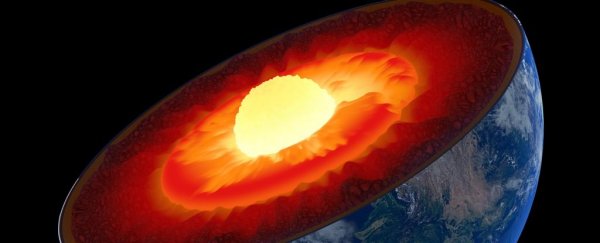Gigantic underground masses of rock the size of hidden continents could have been concealed inside the planet in virtual isolation since Earth first formed, scientists suggest in a new study.
Up until now, not a lot has been known for sure about these two huge, mysterious structures called large low-shear-velocity provinces (LLSVPs). We know that they are there, and that they may affect Earth in strange ways.
Now we seem to have discovered something else about them – and it could turn out to be an important piece of the LLSVP puzzle.
It's always been hard to study these giant continent‐sized provinces in Earth's deep interior, given they exist so very far below the surface – about 2,900 kilometres (roughly 1,800 miles) down, near the boundary of the mantle and Earth's outer liquid core.
Most of what we know about the masses – one located under Africa, the other under the Pacific Ocean – comes from seismic imaging, but there's a significant disconnect between that kind of data and our analysis of deep-origin rock samples that make it to the surface during volcanic events.
"We had all of these geochemical measurements from Earth's surface, but we didn't know how to relate these geochemical measurements to regions of Earth's interior," geologist Curtis Williams from the University of California, Davis told Abigail Eisenstadt at the AGU's GeoSpace blog.
"We had all of these geophysical images of the Earth's interior, but we didn't know how to relate that to the geochemistry at Earth's surface."
Now, it looks like we have a new way to join the dots. Before this, the conventional thinking on LLSVPs was that they were subducted oceanic plates, but in their new study, Williams and his team offer an alternative explanation for the phenomena.
"Our geodynamic simulations predict the present‐day surface expression of plumes to be laterally offset from their lower mantle source locations," the authors explain in their paper.
"When this lateral offset is accounted for, a strong relationship emerges between minimum [helium isotope] ratios in oceanic basalts and seismically slow regions, which are generally located within the two large low shear‐wave velocity provinces (LLSVPs)."
What that means is that there is a hypothetical geochemical link between oceanic rock samples recovered from volcanically active areas and the giant LLSVP continent-sized shapes – provided you don't assume the rocks shoot vertically straight up, which is one way geoscience thinks about these things.
Another way of interpreting the upward movement of rocks from Earth's deep interior, though, is to imagine that they drift around a bit on their long journey to the surface.
The team's modelling – which incorporates such drifting as the rocks rise and flow through the mantle – suggests an extremely primitive form of helium (Helium–3) found in the basalt samples likely originated in the LLSVPs.
If the team is right, it's a big discovery.
"The primitive nature of the LLSVPs indicates these regions are not composed entirely of recycled slabs, while complementary xenon and tungsten isotopic anomalies require the primitive portion of the LLSVPs to have formed during Earth's accretion, survived the Moon‐forming giant impact, and remained relatively unmixed during the subsequent 4.5 billion years of mantle convection," the researchers write.
The team acknowledge that, owing to the nature of their research, the predicted plume shapes in their modelling remain somewhat uncertain, but hopefully in the future, improved mantle tomography models in future studies will be able to reinforce their findings.
In the meantime, it's a new direction in the research, and a new lead in the case investigating these looming, continent-sized mysteries.
"It's a more robust framework to try and answer these questions in terms of not making these assumptions of vertically rising material but rather to take into account how much deflection these plumes have seen," Williams told GeoSpace.
The findings are reported in Geochemistry, Geophysics, Geosystems.
